Back to page 1
The Design
On the day I attended a game at PK Park, notebook and camera in hand, DLR’s Richard Higgins was kind enough to drive down from Portland to show me around. He certainly knew the route well, having made this trip many, many times to meet with University officials regarding the design of the new park.
After coming through the attractive entryway near MLK Blvd., and walking up the impressive stairs (below right) that bring you to the main concourse at the rear of the seating sections, I was immediately struck by one aspect of the park’s structure. The stadium’s roof (below left) was absolutely breathtaking — in both its size and the building material used to make it.
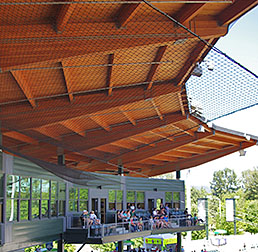 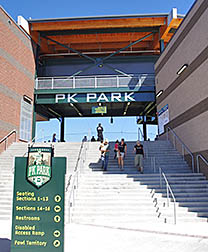 |
So the very first feature of PK Park I asked Higgins about was this roof, as I wondered why in the world so much money was spent on wood for both the roof itself and its supports. I couldn’t think of a ballpark that had opened in decades where the roof was made of real wood. “Remember where we are,” he replied. “This is timber country, and it really wasn’t more expensive to use wood. Besides, look over your shoulder,” and with that, he pointed to the huge south stands of the football stadium.
Indeed, as I peered over at Autzen Stadium’s roof, it was made exactly the same way — with beautiful wood.
PK Park’s roof is not only gorgeous, it’s very functional. Its huge size provides wonderful shade during sunny afternoons and covers a significant portion of the seating bowl when it’s raining. While this last characteristic might seem obvious, it takes on a whole new meaning when you closely examine the playing surface on the field. It looks for all the world like beautifully maintained and mowed grass, with dirt warning tracks and infield.
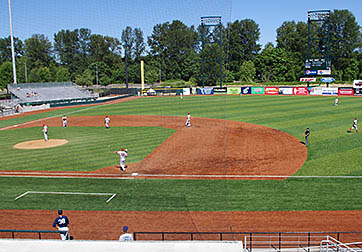 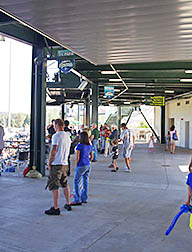 |
And you would be 100% wrong if you assumed that this is what you’re seeing when you look out over the field. With the exception of the dirt mound and the dirt in the batter’s box, everything you see on the playing surface is synthetic. Higgins explained that the latest version of field turf was used, and the warning tracks and “skin” of the infield are not only a different color, but are made of a different kind of fiber that is better for sliding baserunners. And because there is a sophisticated drainage system under the surface, play could continue in a downpour, because you’d have no standing water. That makes the huge roof a great idea, because fans can stay dry in their seats while the game goes on in the rain.
This playing surface has been used at other colleges — notably in Austin — but never for affiliated Minor League contests. This is yet another way PK Park is unique among pro parks.
The concourse at the rear of the seating bowl (above right) is wonderfully open, both toward the field and overhead, as the floor of the upper level is well above you. When I asked DLR’s Esau what aspect of the park he felt turned out the best, he replied. “The concourse. You can get up from your seat and walk around to get your hot dog and visit with friends, while having a great view of the game the whole time.” Esau, a native of New Zealand, added, “The social aspect of attending a baseball game is very important. It’s quintessentially American.”
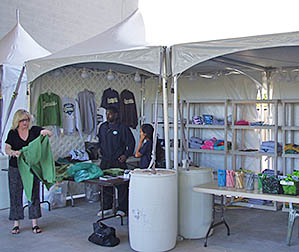  |
The concourse is not without its faults, though. All but one of the concession stands on the concourse are in temporary tents (above right), and perhaps most egregiously, so is the souvenir stand (above left). Virtually every new Minor League park of the past ten years has a permanent merchandise stand, almost all of which are of the walk-in variety. Higgins explained to me that the original plans called for a walk-in souvenir shop on the main concourse behind home plate. However, after construction had started, the University decided to use that space for the one-and-only permanent refreshment stand in the park, thereby pushing the souvenirs to a nearby tent. Fans have also expressed the desire for a nicer venue for merchandise, prompting Emeralds’ first-year GM Allan Benavides to tell me, “I really hope a permanent souvenir store is part of Phase 3 of the ballpark.”
Above the concourse, naturally, are the upper-level luxury suites and press box. All are beautifully done, and the press area in particular is enormous. This wasn’t done with the Ems in mind. No, when the college baseball program reaches the point of hosting NCAA Regionals and Super Regionals — and they are well on their way to that after only two seasons — they’ll need every bit of that room for ESPN and the rest of the media types.
Although most fans will never see it, the space under the stands is very impressive as well. The home locker room (below left), used by the Ducks during the college season and the Ems during the summer, is modern and spacious. It was inspired by the locker room at Vanderbilt’s ballpark. Yes, that is a large recessed “O” in the ceiling which, of course, stands for Oregon.
I would describe the visitors’ clubhouse for you, but there isn’t one … yet. It’s not required for college games, since the opposing team usually shows up at the field in their cleats (or whatever they wear on this synthetic surface) ready to go. One really is needed for Minor League contests, but the Northwest League is making do without one for now. The space for it is graded under the stands on the third-base side, and should be part of Phase 3 of the construction.
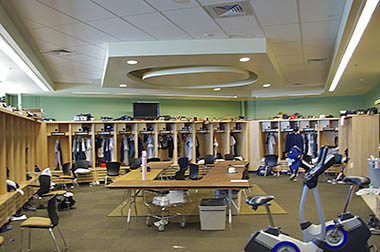  |
Notice one other thing about the home locker room. The shot on the right above shows a locker that is far shorter than all of the rest. Why? It’s for the handicapped baseball player on the Ducks or the Ems.
Of course, there isn’t one … but the Oregon Structure Specialty Code insisted that this locker be built anyway.
There were three other spots where I thought building-code requirements were a little, well, odd. An outdoor sink sits next to a tent that served food to groups on the third-base side. It’s required next to outdoor spots where food is served. Not only that, the sink has to have a cover over it in case water backs up in the drain, because after all, you wouldn’t want back-water splashing up on your hot dog. Second, there is a space-consuming, two-level wheelchair ramp leading down into the home dugout. It was explained to me that the code insisted on it so that the handicapped baseball player can get to the dugout. When this was questioned (asking the City if this access could be accomplished with an electric lift which wouldn’t require nearly the space), the answer that came back was that only a ramp would do. That’s because if the field floods and the baseball player in the wheelchair is the only one left in the dugout, the flood might short out the electric lift and he wouldn’t be able to escape. You can’t make up things like this.
The third example is that the ladies’ restroom on the main concourse is so big it could accommodate all of the females in the City — at once. Well, it seems like it’s that large, but Esau told me that the building code includes a “gender equity” requirement on restrooms. Onalee Carson, the Ems’ personable Media Relations Director, told me that almost without exception, the first time a female fan walks through the doors of the ladies’ room they exclaim “Wow! This is the biggest bathroom I’ve ever seen!”
But the seemingly excessive number of bathroom fixtures goes beyond impressing female patrons, as it does have a longterm benefit. “PK Park is planned to be expandable,” Esau told me. “At present there are more toilets and urinals than required, but when UO expands the park in stage 3, the facility will have the right number of fixtures. This is something that was worked out with the client during the design phase.”
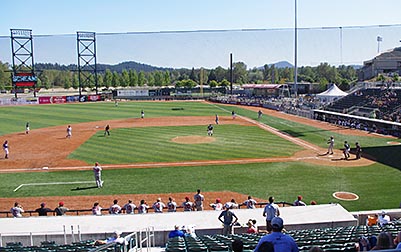  |
The ballpark is also planned for safety — but this sometimes make fans unhappy. “Without a doubt, the biggest complaint we get (from fans) here is that we have too much netting between the stands and the field,” Benavides told me. Indeed, the protective netting is both tall and very wide, extending to the far end of each dugout (above left). Frankly, because the stands are so close to the field, I feel that it’s quite prudent for the netting to be as large as it is. After all, when Charleston, WV’s new park first opened, the fans raved about how great the sight lines were, and how close they were to the action … until, of course, two fans were sent to the ER by screaming foul line drives. Then everyone was clamoring for more protection.
“And we have a ‘fix’ for that,” Higgins told me. “There is a type of netting that is more expensive, but is easier to see through. We’re talking about changing to that next year.”
Benavides also pointed out an oddly positioned stretch of netting that is parallel to the roof, above seats behind home plate (above right). “We added this screen to protect the fans right below there, because ricochets were coming off the press box windows really fast.” Great idea, because the netting catches the foul balls before they have a chance to smack off of those windows.
Oh, and did I mention that the wood roof is beautiful?
So even before Phase 3 is contemplated, the architectural design of PK Park provides for a comfortable, aesthetically pleasing and safe environment … even if the local building codes create some oddities!
The Essentials
So the Emeralds play in a nice place, far better than the hulking, aging Civic Stadium across town. What is the game-day experience like for the fans, though?
 |
First, let’s look at what it costs to attend a game here, starting with parking. Whether you park in the cozy Masonic Lodge lot right across MLK Blvd. or in the expansive football lots, the cost is the same: $3. If you’re running late for the game, believe me, they won’t run out of parking spaces.
Keep in mind that the ticket windows aren’t actually attached to the baseball stadium. You’ll find them across the David & Nancy Petrone North Plaza (everything, it seems, at a college facility has a patron’s name on it) from the park’s main gates. I found the ticket prices to be very reasonable, especially for a brand-new park. The best box seats — those closest to home plate right behind the backstop — cost $12. All of the other chairback seats in the main seating bowl are $9 ($8 for groups over 25). General admission is $6. By comparison, the Salem-Keizer Volcanoes, the closest Northwest League franchise to Eugene, has a ballpark that isn’t nearly (and I do mean not nearly) as nice as PK Park, charges the same $3 for parking and, on average, more for seats that aren’t as close to the field as in Eugene. In other words, I think the Emeralds’ prices aren’t bad at all.
A popular spot for groups is the picnic area down the first-base line. Here a pre-game BBQ is provided, and part of the area is covered by a canopy (below left). The cost per person (which includes your admission to the game) is either $25 or $21, depending on which set menu you select. This area was really abuzz with activity at the game I attended. The designation of the area as “Fowl Territory” (remember, the UO team nickname is the Ducks) is really cute.
 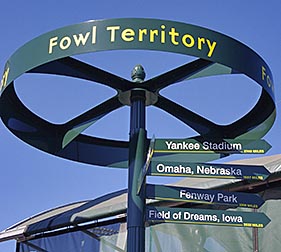 |
By the way, you don’t have to pay for a program, because you are handed one when you walk in. The Ems also offer a fair selection of souvenirs at very reasonable prices, but I think the whole process of shopping for team merchandise suffers from the lack of a permanent stand or walk-in store.
As I mentioned, there’s only one permanent concession stand, and it offers your standard hot dogs, peanuts and sodas. The more interesting food items, though, are offered at the string of “tents” along the concourse on the third-base side. The Ems call this area “Restaurant Row,” because popular Eugene eateries set up shop here each game. For instance, Hole In The Wall Barbecue serves pork or beef sandwiches for $6.50 that have gone over very well at Ems games, and Benedetti’s Meat Market & Deli has several kinds of subs for $6. I had one of their absolutely outstanding turkey and avocado subs. The beers on tap cost $5 for domestics and $6 for “premiums.”
Most parks of this size don’t have more than one scoreboard, but in a way, PK Park has three. The main “informational” board is in left field. Because its numbers are hard to read when the setting sun is shining directly on it during evening games, a manual scoreboard was added in right field at the back of the bullpen. There’s also a color video screen in right-center field. Its job is to provide background info on the batter. There was only one problem with it: it never showed anything (even the name) of batters from the visiting team. I asked Benavides why this was, and he said, “BAM (MLB’s statistics and media arm) is having trouble transmitting the right information to us. We’ve pinpointed the problem, though, and it should be fixed by our next homestand.”
There is an expansive area beyond the right-field fence that has one purpose for the college players, and quite a different one for the Ems’ young fans. This spot, which is completely outfitted with the same field turf as the playing field, is called the Player Development Area by the Ducks, but the Funzone by the Emeralds. During the pro games, this is the domain of youngsters, whose parents pay $3 for the kids to play on the inflatable games and attractions, all within a completely fenced-in area.
Summary
So how does PK Park measure up? As a college ballpark, it’s very, very nice. In the PAC 10 conference, it’s not as large as, say, the facilities at Arizona or Arizona State, or as aesthetically pleasing as Stanford’s Sunken Diamond, arguably the most picturesque baseball venue on any campus in America. The Ducks probably care most about how it compares to Goss Stadium, which sits on the same plot of land on which Oregon State has been playing baseball for over a century. Well, while the Beavers have become one of the best baseball programs in the country, they’ve also made a lot of enhancements to their ballpark in recent years.
Still, I would have to say PK Park is nicer. It has much more of a traditional baseball look, with a lovely roof (and I’ve always been a big proponent of overhangs or roofs over grandstands, even though this is more of an Eastern U.S. look than a Western one) and a true upper level for suites and the press box.
 |
This lends itself much better to pro games, too. In fact, among short-season A parks, PK Park more than holds its own. And once Phase 3 is done, and a visitors’ clubhouse and more-permanent souvenir and concession stands are added, it will be as nice as any in the Northwest League. And I can’t overstate how much nicer it is than Civic Stadium across town.
  |
When I asked Justin Stranzl, Client Liaison at DLR’s Portland office, what aspect of PK Park he felt turned out the best, he said, “I think it’s the fan experience. We created a park where people are going to be excited to see baseball, because we thought as much about the fans in the stands as the players on the field.” And he should know, because Stranzl is a graduate of Penn State, where Medlar Field forged two important paths: how to make a ballpark look attractive next to a mammoth football stadium; and how to have a successful partnership between a college baseball program and a pro team.
And in Eugene, I think PK Park hit both of those nails on the head … and when you look around the country, you indeed see that both are rare feats.
By the way, I’d be remiss if I failed to thank everyone at DLR for all of their input, especially Richard Higgins. He and the Ems’ Onalee Carson (both of whom are in the photo above) acted as my tourguides at beautiful PK Park.
My wife and I have been to several games at PK and previously Civic Stadium as well as other minor league parks over the past years.
PK is the best to view a baeball game, feel welcomed and cared for than others. We just went the 2017 NWL playoffs and even with a small crowd, they showed great support for their team, the Ems. (Wished we lived closer as we would be season ticket holders.)